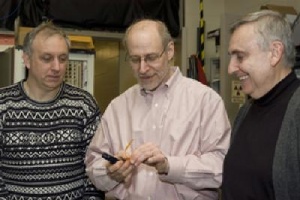Mar 9 2009
The University of Cincinnati has long been known for its world-record-breaking carbon nanotubes. Now researchers at the University of Cincinnati have discovered new uses by spinning carbon nanotubes (CNTs) into longer fibers with additional useful properties.
 Mark Schulz, David Mast and Vesselin Shanov (left to right) from the University of Cincinnati have created new applications for spun carbon nanotubes for both military and consumer use. Credit: Lisa Britton/UC photographic services
Mark Schulz, David Mast and Vesselin Shanov (left to right) from the University of Cincinnati have created new applications for spun carbon nanotubes for both military and consumer use. Credit: Lisa Britton/UC photographic services
Taking technology that has already been proven to grow carbon nanotubes of world-record breaking lengths, researchers Vesselin Shanov and Mark Schulz in the UC College of Engineering NanoWorld Lab have now found new applications by spinning these fibers into strong threads.
David Mast, from UC's McMicken College of Arts and Sciences, saw possibilities in the threads. Mast, an associate professor of physics, took a 25-micron carbon nanotube thread and created a dipole antenna using double-sided transparent tape and silver paste. He was immediately successful in transmitting radio signals.
"It transmitted almost as well as the copper did, but at about one ten-thousandth of the weight," says Mast.
"Then I decided to dismantle my cell phone," says Mast. He created a cell phone antenna, using CNT thread and tape. Ripping the back off his own cell phone, he tore out the phone's original antenna and replaced it with his home-made one. With the "nano-antenna" or "nantenna," he was able to get four to five "bars" of service, compared to none when he removed it.
"That was a very pleasant surprise, how easy it was to do," Mast says. "The hardest thing is to manipulate them. They float on ambient air."
From there it was an easy leap to video, in which he was again successful. "I want to now set up a wireless webcam for the lab using these thread antennas so
Mast says that the key to the new applications is the quality of the material that Schulz and Shanov came up with using multi-wall carbon nanotubes.
"They spin thread that is of such high quality, it opens the door to incredible possibilities," says Mast. "This is just one of many potential applications."
Schulz explains that the carbon nanotube threads work well as an antenna because of something called the "skin effect."
"The electrons transfer well because they want to go to the surface," he says. "Instead of traveling through a bulk mass, they are traveling across a skin."
"Copper wire is a bulk material," Shanov points out. "With carbon nanotubes, all the atoms are on the surface of these carbon structures and the tubes themselves are hollow, so the CNT thread is small and light."
"Carbon thread that is a fraction of the weight of current copper conductors and antennas could directly apply and would be significant to aerospace activities — commercial, military and space," he adds. "On any aircraft, there are about several hundred pounds of copper as cables and wiring."
Mast points out that the threads have what he calls an "immensely high tensile strength — perhaps five times that of steel and yet they are less dense than steel."
Now that the team has shown the feasibility of such applications, the next steps will be to work on improvements (such as making yarn out of several threads) and to find industries that will commercialize CNT thread.
Mast's next step was going to be to buy a new cell phone. However, he says, "it works so well now that I decided to just upgrade to a new antenna made of carbon nanotube yarn."
This research was funded by the National Science Foundation (with technical monitors Shaochen Chen, Shih-Chi Liu, and K. Jimmy Hsia), and North Carolina A&T SU (collaborators Jag Sankar and Sergey Yarmolenko) through their NSF-ERC (technical monitor Lynn Preston) and ONR-CNN (technical monitor Ignacio Perez) projects.